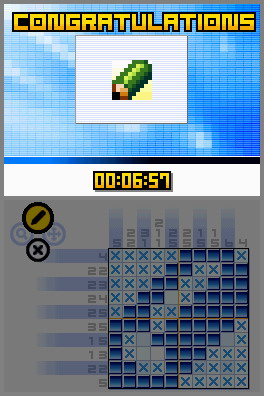The Beauty of Picross
April 26th, 2013
I’ve only just started the 15×15 puzzles, but I thought that I’d jot down a few ideas about Picross DS.
- Although Picross can sometimes seem impenetrable, the player can never get stuck, it’s all a matter of looking at the numbers and figuring things out logically.
- Hidden behind the simple premise are a range of deduction techniques that the player internalises through play. One of the game’s strengths is how these techniques organically emerge from the basic set of rules. You can read about them here.
- Because the player makes deductions by adding information to the board and deductions are made based on the current available information, every time a deduction is made, the nature of the puzzle is fundamentally altered. So in order to solve a puzzle, the player must continually re-adjust their mental orientation.
- The player can often make more than one deduction at the one time, so two players can solve a puzzle in two entirely different ways.
- Picross is about the way small actions build to a greater whole.
- Because information is Picross’s currency, filled squares are just as important as crossed squares, even though crossed squares don’t etch out the image. This is why punctuation is so critical.
- There should be a third camera control option for 15×15 puzzles, where the grid is large enough that the player must manually control the camera, that allows the player to move the camera with the d-pad and fill in squares with the stylus. This would prevent the player from having to manually switch back and forth between the scrolling and input functions.
Like Crosswords DS, which I’ve been playing semi-regularly for 3 years now, I guess it’ll take me a long time to finish Picross DS.




 Game Design Companion: A Critical Analysis of Wario Land 4 - $7.99
Game Design Companion: A Critical Analysis of Wario Land 4 - $7.99 Level Design: Processes and Experiences
Level Design: Processes and Experiences Speed Boost: The Hidden Secrets Behind Arcade Racing Design - $5.99
Speed Boost: The Hidden Secrets Behind Arcade Racing Design - $5.99 Adventures in Games Analysis: Volume I - $5.99
Adventures in Games Analysis: Volume I - $5.99







